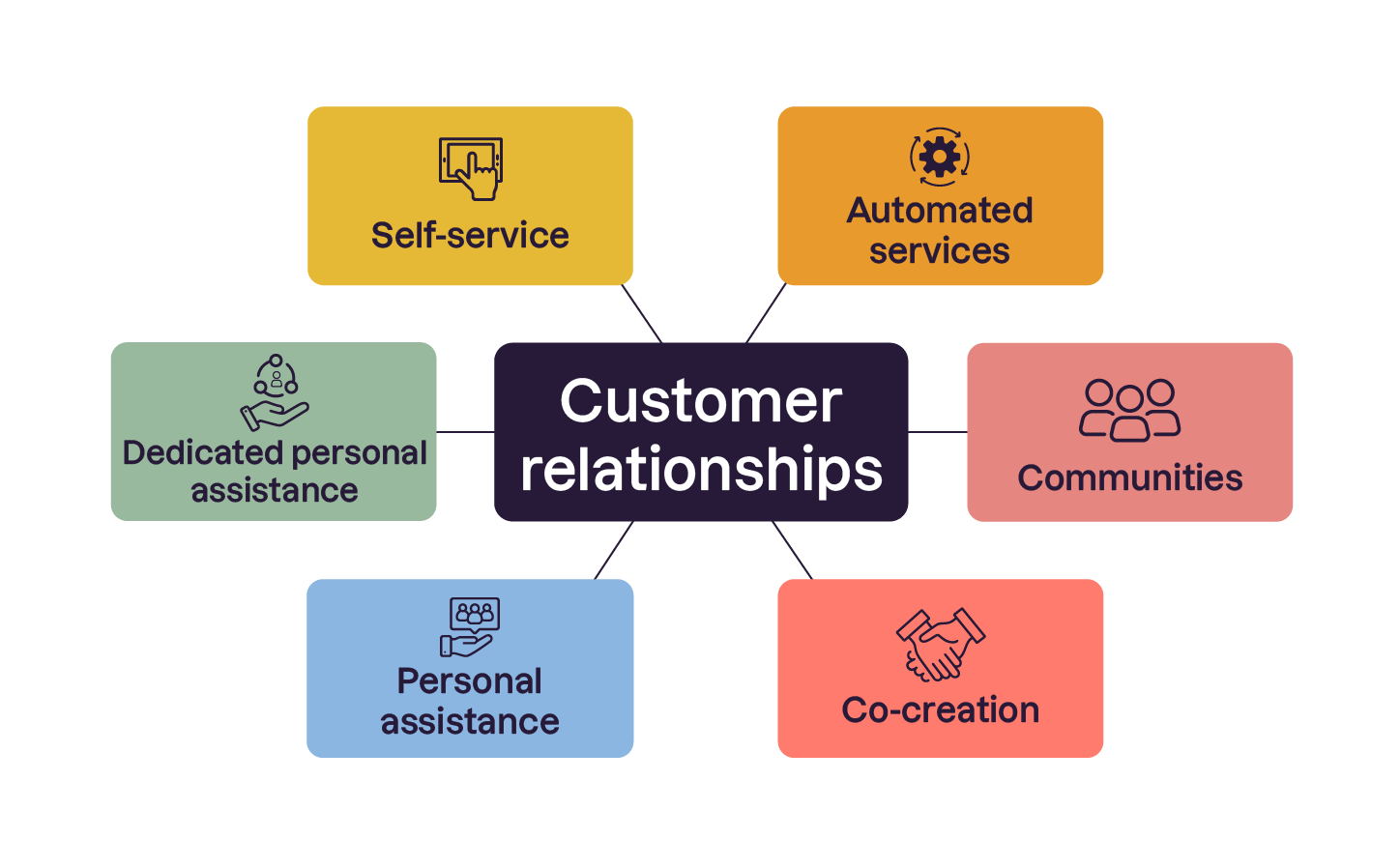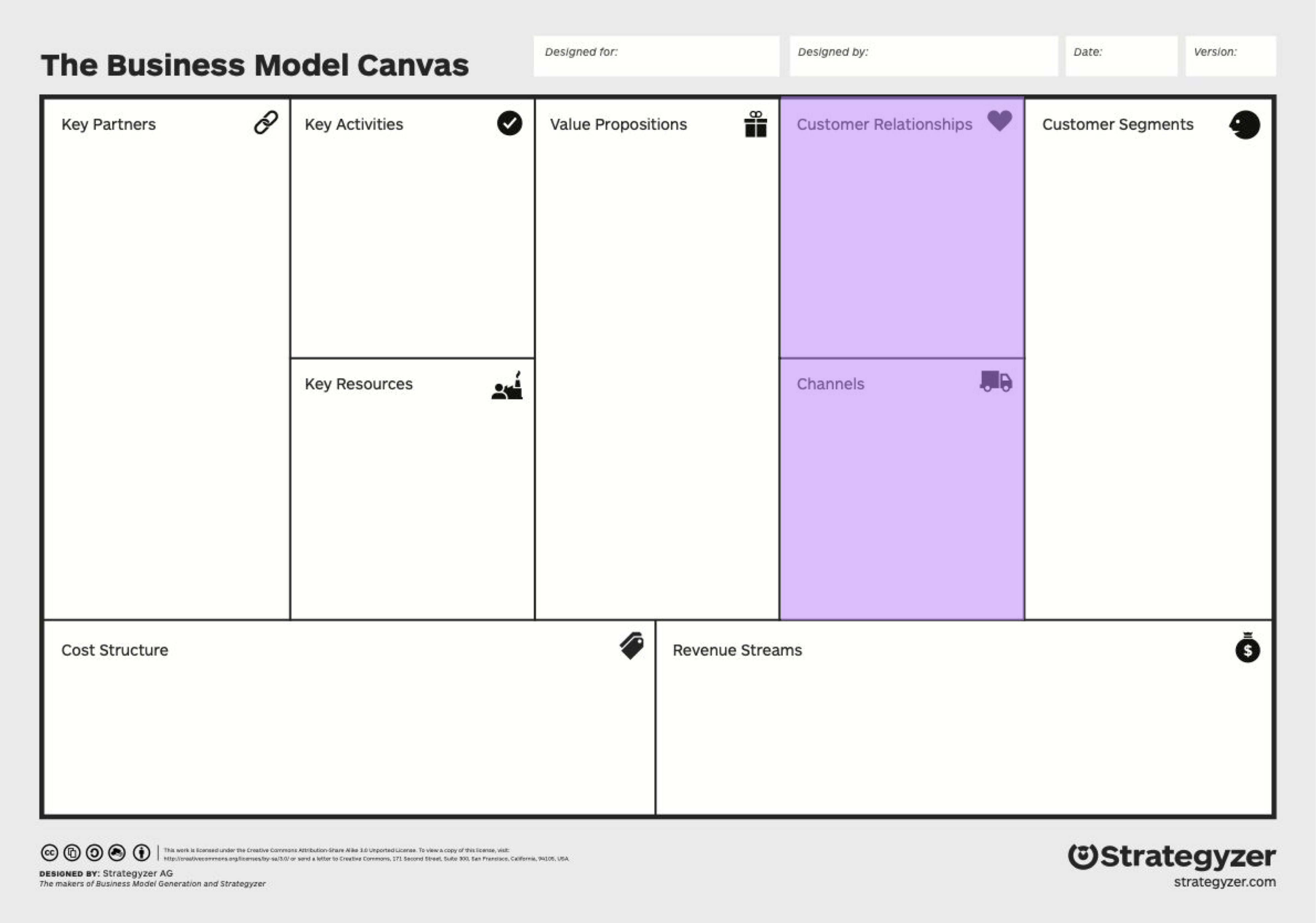Consider Your Channels and Define Your Customer Relationships

Mục Lục
Find Out How to Engage With Customers
The Customer Relationships box outlines how your interactions will unfold and addresses questions such as:
-
Are we hoping for a long-term relationship or a short-term relationship?
-
Does each customer need to speak to a person (or use technology)?
-
If so, does it need to be a particular person or the same one each time they return?
-
Will we need to work harder to acquire or retain customers?
-
Does one tend to happen more naturally than the other?
Customer relationships can be divided into six main categories:

1. Personal Assistance
The human touch distinguishes this kind of consumer engagement. Customers can interact with a salesperson when deciding what to buy or with a customer service professional for post-sale services. This would be like going to a good department store where a knowledgeable salesperson can advise a customer on the options.
2. Dedicated Personal Assistance
This relationship elevates personalized assistance by allocating devoted customer care professionals to the client. The representative uses their knowledge of the customer to personalize the interaction. This type of relationship requires some time and skill to build. You might see this level of personal service provided in B2B corporate banking.
3. Self-Service
The DIY approach is becoming more popular as businesses look for ways to reduce costs so savings may be passed on to customers – or profits improved. In this form of connection, the business provides the means for the clients to help themselves.
4. Automated Services
Automated services, which offer tools and procedures that make it more convenient for clients to do services on their own, are the next evolution of self-service. These services are typically much more tailored and build a profile of a customer’s online and purchasing habits before offering ideas to improve their shopping experience. You can compare automated services to personal support due to the customization. A great example of this would be Amazon – they obsess about making the self-service user experience so good that customers feel in control and understood.
5. Communities
Communities provide a great way for businesses in today’s social media-driven climate to understand their customers, gain insights into their habits and opinions, and build a space where clients can exchange information and experiences. By doing this, the business not only develops a personal relationship with its clients, but also the additional connections between the clients that enhance these bonds.
6. Co-Creation
By including people in creating the final product, businesses are rapidly altering the nature of customer relationships. This increases client ownership of the goods and services and frequently leads to the emergence of market leaders for certain goods or brands. For example, YouTube depends on its customers to create content, which they do in huge numbers. This enables the website to boast being the largest video-sharing website in the world. Or Lego, which often sources new product ideas from its customers.
Explore the Relationship Your Business Will Have With Its Customers
The relationship will change depending on the touch point with the customer. Those moments could happen all through the customer’s purchase journey. Let’s consider when our business, The Founders Reading Guild, will be in touch with customers:
 Interactions with the customer
Interactions with the customer
-
Awareness – We will need a mechanism to make them aware of us.
-
Discovery – Before they sign up with us, they might want to explore our offering to evaluate its attractiveness.
-
Purchase – If we get past this stage, they will be ready to sign up and subscribe.
-
Product selection – Members will expect a personalized book selection, so we need the means to learn about them (maybe at registration) and know what they have read (or not).
-
Managing their account – They will want to be able to access their account and see what books are up next. Maybe even see why they’ve been selected for them.
-
Delivery – Members will want the books delivered promptly and professionally.
-
Events – They might want to come to invite-only, exclusive events we host to learn from other founders.
We must ensure that all these are perfectly designed to create the experience and deliver the value proposition.
Which of these customer relationship categories do you think are most relevant for The Founders Reading Guild?
-
Personal assistance
-
Dedicated personal assistance
-
Self-service
-
Automated services
-
Communities
-
Co-creation
You’ll get a chance to see what I think when we complete the BCM blocks at the end of this chapter. First, let’s look at the channels through which we maintain our customer relationships.
Reach Your Customers
Now, let’s consider how we reach and engage with our customers.
First, we must explain how we first encounter our customers and deliver our value proposition. These would be represented on the BMC as channels.
For example, your business might find customers through Google Ads or Facebook, then serve customers through face-to-face workshops or drop-shipped packages. You would list both of these in the channels segment.
Your business’s customer interface is made up of channels. Your channels are places where customers can interact with you and are crucial to the customer experience.
Channels have different roles. Here are a few of the objectives of a typical channel:
-
A means by which a company can inform the targeted client segments about the goods and services it offers.
-
Gives customers a chance to review and assess the value proposition of the company.
-
Allows clients to purchase the goods or services of their choice.
-
Delivers the value proposition to the client.
-
Provides after-sales services to the client.
Types of Channels
Bringing a value proposition to the market requires finding the ideal combination of channels to fulfill customer preferences for how they want to be reached. You can reach customers through your own channels, those of your partners, or a combination of both.
Owned Direct
These owned channels might include an internal sales team, a website, or retail locations that the company owns or manages. Owned channels offer larger margins as you don’t have to pay someone else to access their audience, but they can be expensive to set up and maintain.
Let’s consider an example. You run a direct-to-consumer retail business selling smart, creatively beautiful wall calendars. To reach your customers, you have a blend of different channels. Owned direct channels could be the following:
-
A website that showcases calendars and allows people to purchase directly. It costs to set up the website, but you keep all the revenue.
-
You might set up a pop-up shop in the lead-up to Christmas.
Partner Indirect
Partner channels are indirect and include many possibilities, including retail sales, wholesale distribution, and partner-owned websites. Partner channels result in lower margins, but they also give a company a chance to reach more people and gain from the qualities of its partners.
Partner indirect channels for your wall calendar company could be the following:
-
Use Google and Facebook for paid marketing purposes (to access their audiences).
-
Sell products through Amazon and Etsy. They take a cut of the sales.
-
A distributor to distribute calendars at scale to retailers all over the world. Although you would benefit from the scale, you would need to take a lower price per calendar.
Getting the idea? Try it yourself!
Your Turn! Think of Channels for Our Business

When considering the channels we need for The Founders Reading Guild, it’s helpful to remember that these channels are how our business connects with our customers and delivers our value proposition.
The relationship between channels and customer relationships is particularly strong. Therefore, you select channels to deliver the relationship you want with your customers; to meet their needs and enable the type of interaction and service you want.
So, it’s a good idea to review how we have completed the Customer Relationships block and note which channels we need to execute.
Are there apparent channels we need when we connect/interact with the customer? Let’s think about each one briefly:
-
Awareness – What channels would help us raise awareness of our offering?
-
Discovery – Through what channels can we provide information to help our customers understand our value proposition?
-
Purchase – What channels do we need to enable the purchase process?
-
Product selection – What channels will enable us to capture customer information?
-
Managing their account – What channel would the customer use to manage their account?
-
Delivery – What channel(s) would we need to ensure the books are delivered to the customer?
-
Events – Are there any channels associated with events?
Answer some of the questions above, and then let’s move on to completing the BMC for The Founders Reading Guild, and we’ll share what we have completed in these blocks.
Fill In the Channels and Customer Relationships Blocks
So, let’s see where on the BMC these two blocks are – Channels and Customer Relationships:
 Channels and Customer Relationship segments
Channels and Customer Relationship segments
You will first notice that they are close together since there is an obvious relationship between them. The second thing you might see is that they are situated right next to the Customer Segments block.
These three boxes tend to pair neatly together.
By understanding our customers’ desires and preferences, we can identify the best methods for recruiting and keeping them for years to come.
✅ Complete these two fields now, and check how I filled in the Customer Relationships and Channels boxes to compare.
Let’s Recap!
-
Channels describe how your company communicates with and reaches your customer segments to deliver your value proposition.
-
The customer relationship articulates the nature of a company’s relationships with its various customer segments. The customer relationships that an organization opts for are based on the company’s business model and have implications for customer experience.
-
There are owned direct channels that enable businesses to connect directly with their customers and partner indirect channels, where they connect via partner channels.
We’ve done quite a thorough work on our Business Model Canvas by now! There are just two blocks left to fill, which we will do in the next chapter.















![Toni Kroos là ai? [ sự thật về tiểu sử đầy đủ Toni Kroos ]](https://evbn.org/wp-content/uploads/New-Project-6635-1671934592.jpg)


